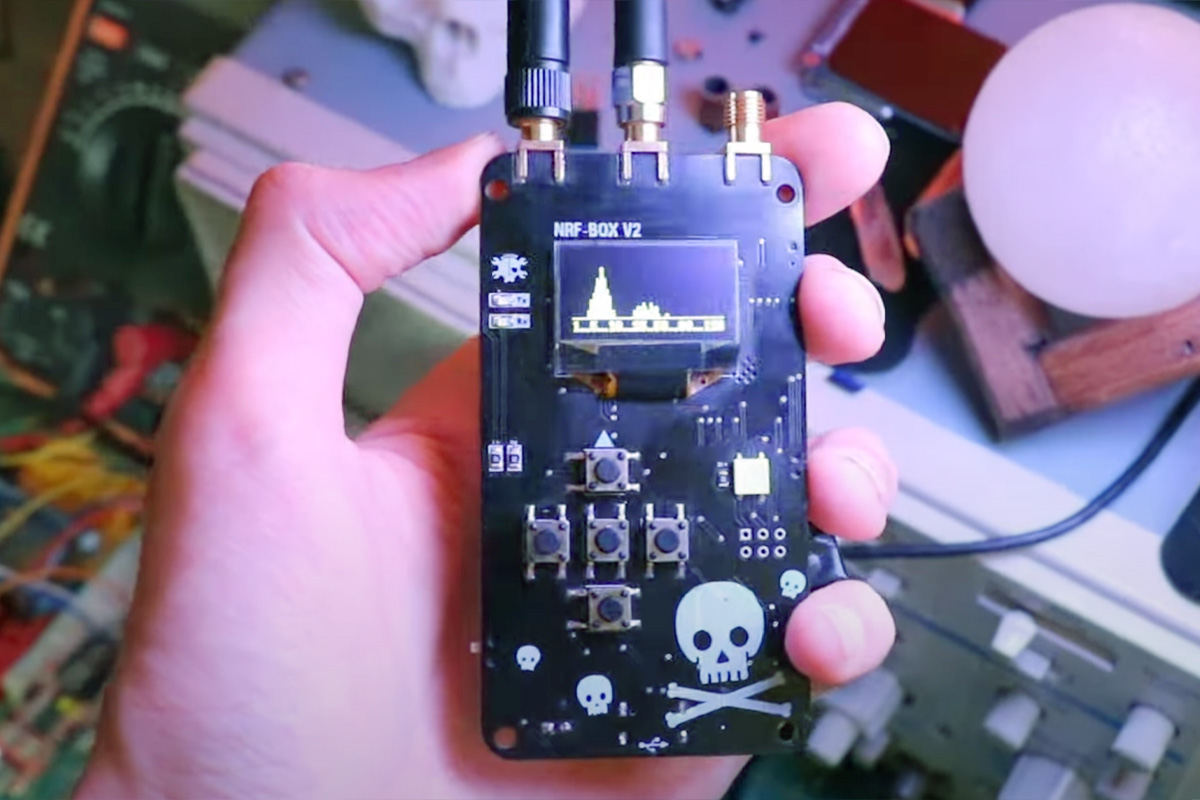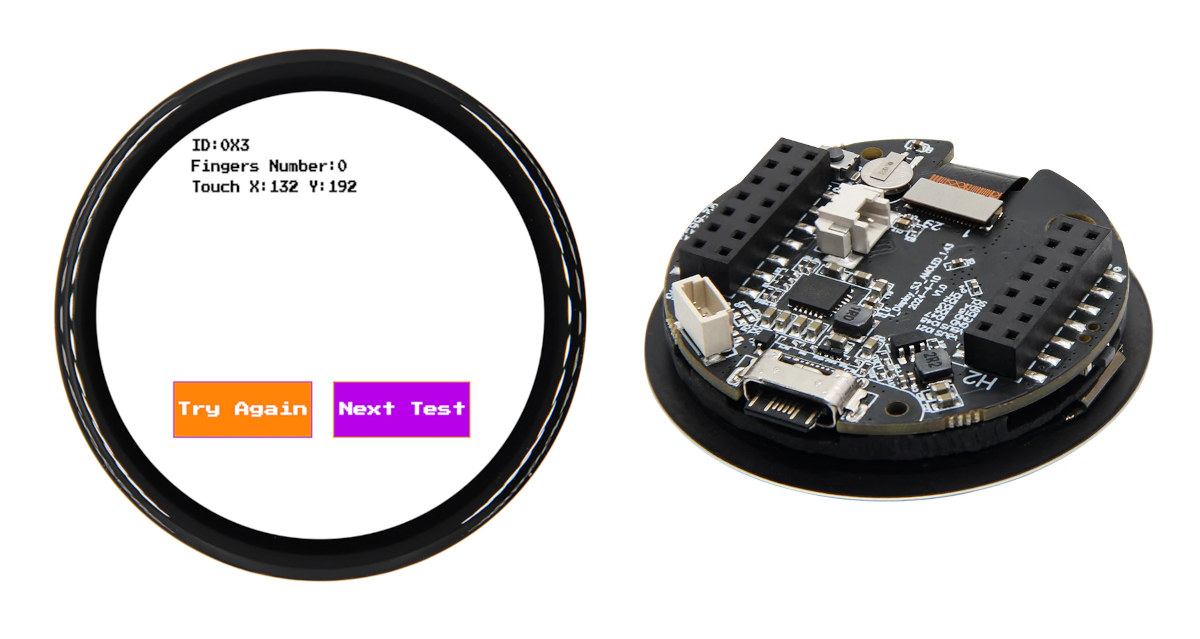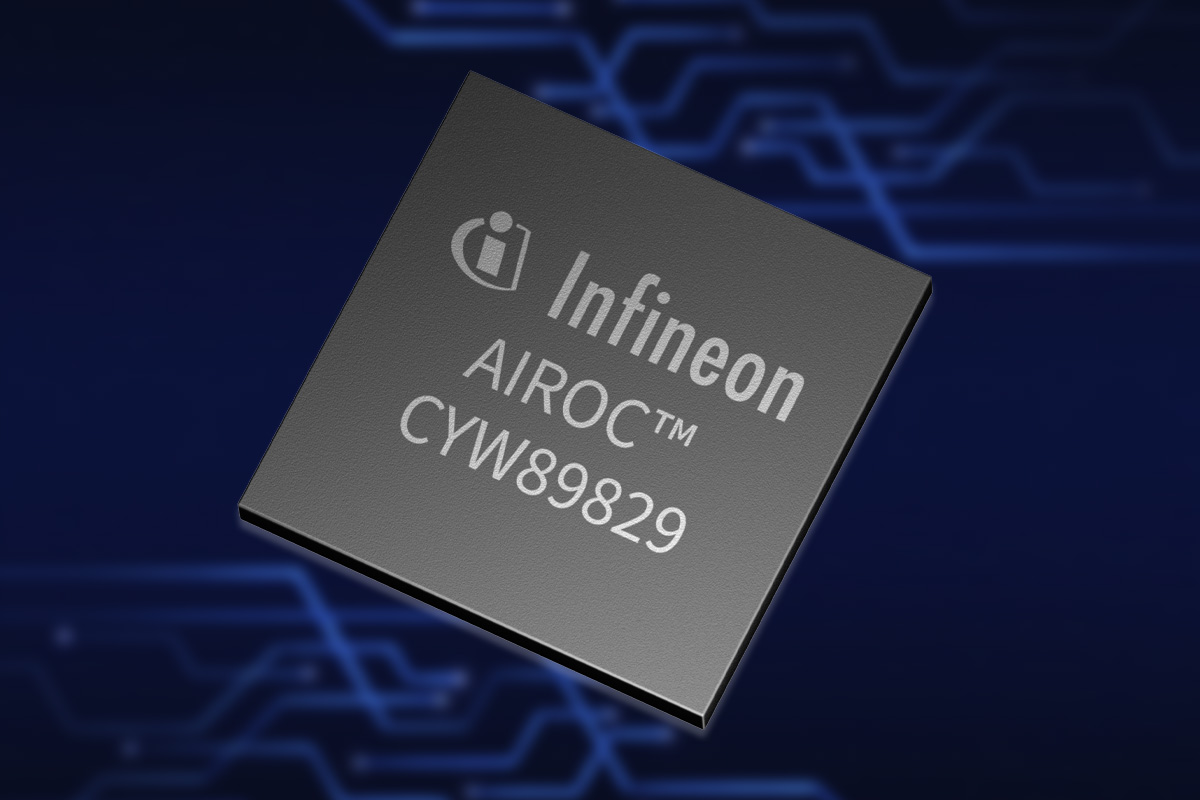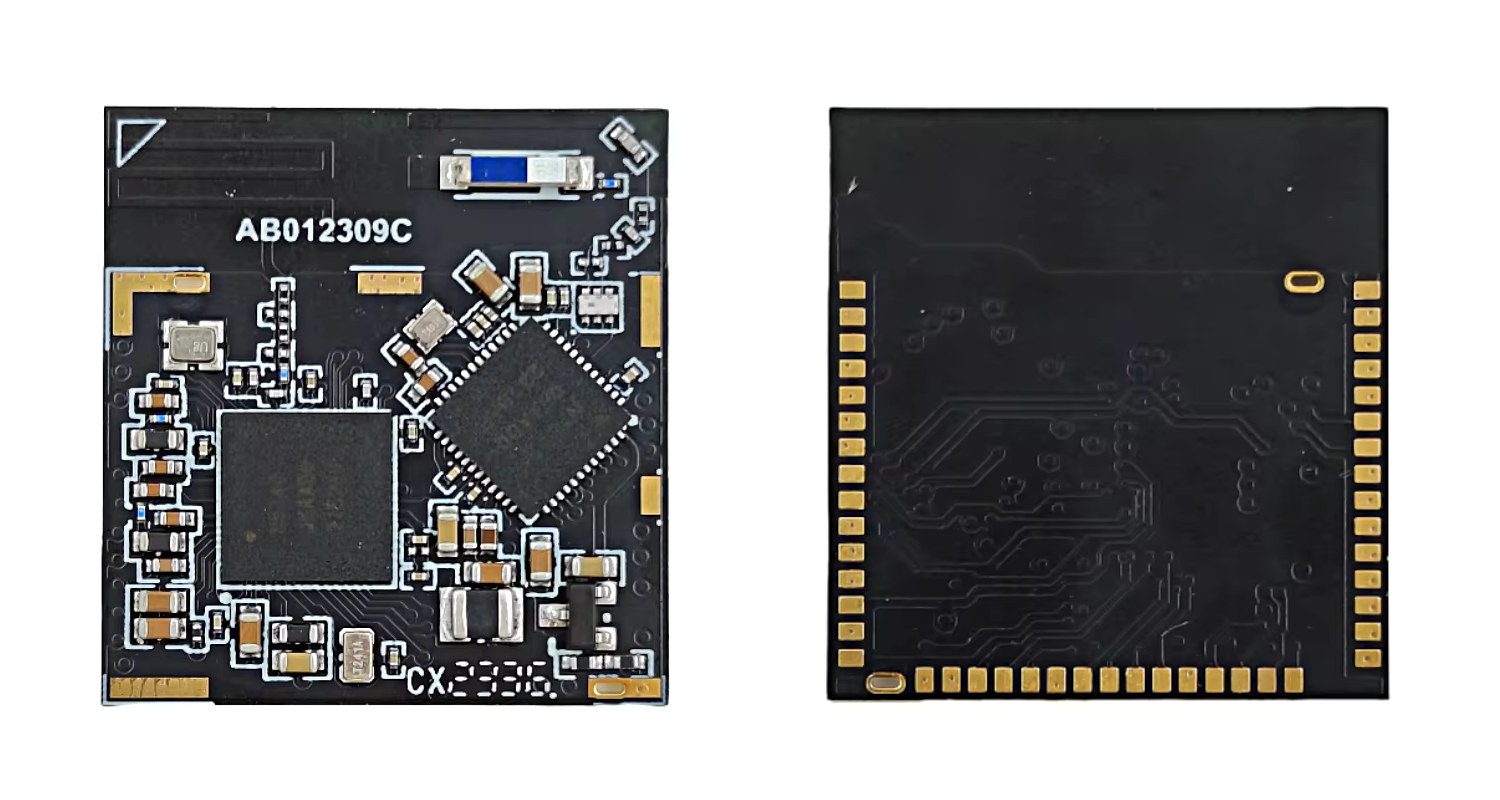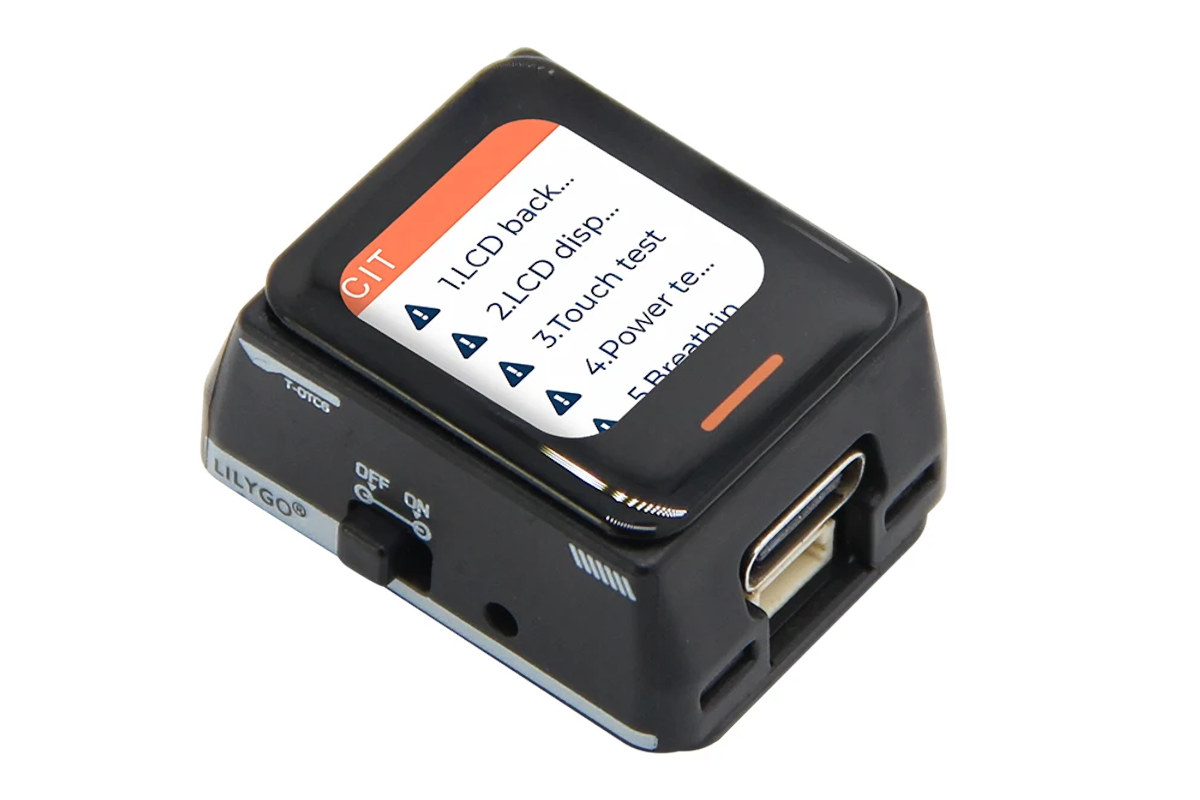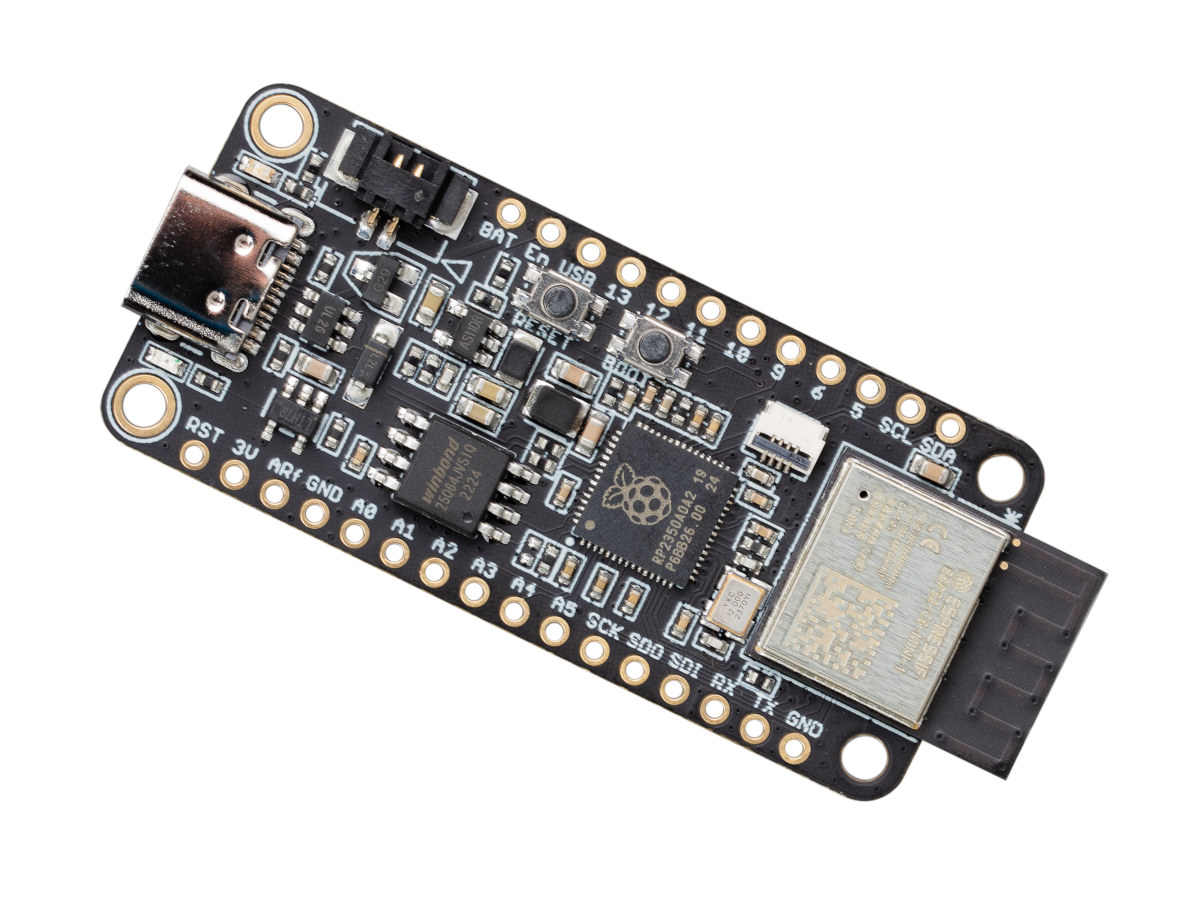CiferTech has recently introduced the nRFBOX V2 ESP32-based wireless hacking tool designed for spectrum analysis, jamming, BLE device emulation, and more. The device is built around an ESP32-WROOM-32U module and includes an NRF24 module covering the whole 2.4GHz spectrum. Additionally, the device has a 0.96-inch OLED display, a five-way microswitch control pad, and a WS2812 RGB LED for feedback. The device can also be operated with a single 3.7V lithium battery, and that batter’s charging is handled by a TP4056 charging IC. All these features make this device useful for wireless security testing, educational environments, research, and hobbyist projects. Previously we have written about similar portable hacking tools like the DSTIKE Deauther Watch X, the HackBat pen-testing device, and the popular Flipper Zero wireless hacking tool. Feel free to check those out if you are looking for similar products. nRFBOX V2 specifications Microcontroller – ESP32-WROOM-32U with ESP32 dual-core wireless microcontroller […]
Bluetooth 6.0 features accurate two-way ranging using Channel Sounding, latency reduction, improved scanning efficiency, and more
The Bluetooth Special Interest Group (SIG) has just announced the release of the Bluetooth 6.0 Core Specification with features and feature enhancements that include Bluetooth Channel Sounding for two-way ranging between BLE devices, decision-based advertising filtering and monitoring advertisers to improve device scanning efficiency, an enhancement to the Isochronous Adaptation Layer (ISOAL) for lower latency and higher reliability, the LL extended feature set, and a frame space update for throughput optimization. Bluetooth 5.4 was released as a minor update mostly adding electronic shelf label (ESL) support in February 2023, or about 18 months ago, but Bluetooth 6.0 is a major update with the most notable feature being Bluetooth Channel Sounding to enable two-way ranging between two Bluetooth LE devices. It’s not the first time we’ve heard about “Bluetooth Channel Sounding” for distance measurements as it was implemented in WiFi 7/6 and Bluetooth 5.4 chipsets such as Synaptics SYN4382 and Broadcom […]
T1000-E Card Tracker is a thin, credit card-sized GPS tracker with Meshtastic support
Seeed Studio has introduced the T1000-E, an updated version of the SenseCAP T1000 Card Tracker, built for Meshtastic. This rugged tracker is compact, about the size of a credit card, making it easy to carry or attach to assets. It uses Semtech LR1110 RF transceiver, Nordic Semi nRF52840 wireless SoC, and MediaTek/Aihora AG3335 GPS module for precise, low-power tracking and communication. With an IP65 rating for dust and water resistance, the T1000-E is ideal for reliable asset tracking. The T1000-E supports LoRa and Bluetooth v5.1 for communication and includes a 3-axis accelerometer, an LED, a buzzer, and a button for operation. It has internal antennas for GNSS, LoRa, Wi-Fi, and BLE communication range of 2 to 5 km, depending on the environment. SenseCAP Card Tracker T1000-E specifications: SoC – Nordic Semiconductor nRF52840 CPU – 32-bit Cortex-M4 core with FPU running at 64 MHz Flash – 1 MB RAM – 256 kB […]
T-Display-S3-AMOLED-1.43 – A 1.43-inch round AMOLED touchscreen display with an ESP32-S3 wireless MCU
We’ve already seen a few ESP32-S3 boards with an AMOLED display and plenty with round displays such as SB Components’ Dual Roundy, LILYGO T-RGB ESP32-S3, MaTouch ESP32-S3 Rotary IPS display among others, but I had yet to see an ESP32-S3 board with a round AMOLED display. That’s just what the LILYGO T-Display-S3-AMOLED-1.43 has to offer. The ESP32-S3 board features a 1.43-inch round AMOLED with 466×466 resolution and a capacitive touchscreen, a microSD card slot for storage, an RTC with backup battery, two 14-pin headers and a Qwiic UART connector for expansion, a USB-C port for power/charging and programming, and a 2-pin connector for a LiPo battery. T-Display-S3 AMOLED-1.43 specifications: SoC – Espressif ESP32-S3R8 CPU – Dual-core Tensilica LX7 microcontroller up to 240 MHz with vector instructions for AI acceleration Memory – 8MB PSRAM Wireless – WiFi 4 and Bluetooth 5.0 LE + Mesh connectivity Storage – 16MB SPI flash, MicroSD […]
Infineon AIROC CYW20829 Bluetooth LE 5.4 MCU and module family targets industrial, consumer, and automotive applications
Infineon has recently released the AIROC CYW20829 Bluetooth LE (Low Energy) 5.4 family which now includes SoCs and modules. These SoCs include two Cortex-M33 MCU cores: one 48 or 96 MHz application core for the peripherals, security, and system resources, and one communication core for the 2.4 GHz RF transceiver with up to 10 dBm transmit power and -98 dBm receive sensitivity. This high integration reduces bill-of-material (BOM) costs for a wide variety of applications, including PC accessories, low-energy audio, wearables, solar micro inverters, asset trackers, home automation, and others. Back in 2021, we saw Infineon release the AIROC CYW5557x family of Wi-Fi 6/6E SoCs for IoT and streaming devices with features like enhanced range and improved network efficiency. More recently, Infineon announced the PSOC Edge E81, E83, and E84 MCU based on Cortex-M55/M33 microcontrollers. Feel free to check those out if you are looking for Infineon-specific MCUs. Infineon AIROC […]
Abluetech PTR7002 WiFi 6 and PTR5302 WiFi 6 and BLE 5.4 modules feature Nordic Semi nRF7002/nRF5340 wireless chips
Shenzhen-based Abluetech has launched two low-power wireless modules based on Nordic Semi nRF7002 and nRF5340 wireless chips. The PTR7002 is a dual-band WiFi 6 module based on the nRF7002 chip, and the PTR5302 module combines the nRF7002 with the nRF5340 wireless microcontroller to offer dual-band WiFi 6 and Bluetooth LE 5.4 connectivity Abluetech PTR7002 dual-band WiFi 6 module with nRF7002 PTR7002 specifications: Chipset – Nordic Semi nRF7002 Wireless Dual-band Wi-Fi 6 Tx power – Up to +21dBm Rx sensitivity – -96.5dBm @ 2.4GHz / -90.5dBm @ 5GHz PHY bandwidth – Up to 86 Mbps (MCS7) 1SISO; 20MHz bandwidth Modes – Station, Wi-Fi Direct, Soft AP (Wi-Fi 4 operation only), simultaneous Station +Soft AP/Wi-Fi Direct/Station modes. 2.4GHz and 5GHz dual-band PCB antenna Range – Up to 300 meters Host interface – SPI / QSPI; AT command set Supply Voltage – 2.9 to 4.5V Power Consumption (@ 3.6V TBC) Tx peak current […]
LILYGO T-QTC6 – An ESP32-C6 IoT controller with a 0.85-inch touchscreen LCD
LILYGO T-QTC6 is a cute little IoT controller based on an ESP32-C6 WiFi 6, Bluetooth 5.4 LE, and 802.15.4 wireless microcontroller and a 0.85-inch touchscreen color LCD that can be powered via USB-C or a LiPo battery with the board also supporting charging. The device, sometimes called “T-QT C6” (with a space), also comes with an 8-pin female connector with five GPIOs and a Qwiic connector for UART modules. It’s another addition to the T-QT family with ESP32 wireless microcontrollers and a tiny 0.85-inch display such as the T-QT Pro or the T-QT V1.1. But note that those are development boards, while the T-QTC6 feels more like a complete device. LILYGO T-QTC6 specifications: Wireless Module – Espressif Systems ESP32-C6-MINI-1U SoC – ESP32-C6-FH4 32-bit RISC-V microprocessor up to 160 MHz with 320KB ROM, 512KB HP SRAM, 16KB LP SRAM, 4MB flash Memory – 4MB PSRAM (TBC) Wireless 2.4 GHz WiFi 6 […]
Challenger+ RP2350 WiFi6/BLE5 board combines Raspberry Pi RP2350 MCU with ESP32-C6 WiFi 6 and Bluetooth 5.4 LE module
You don’t need to wait for the Raspberry Pi Pico 2 W to get a Raspberry Pi RP2350 board with WiFi and Bluetooth thanks to the Challenger+ RP2350 WiFi6/BLE5 board that combines an RP2350A microcontroller with an ESP32-C6 module offering 2.4 GHz WiFi 6 and Bluetooth 5.4 LE connectivity. The board follows the Adafruit Feather form factor with 28-pin through holes for I/Os making it compatible with FeatherWings add-on boards. It comes with a USB-C port for power and programming, and a JST connector plus a charging circuit for people wanting to connect a LiPo battery. Challenger+ RP2350 WiFi6/BLE5 specifications: Microcontroller – Raspberry Pi RP2350A MCU CPU Dual-core Arm Cortex-M33 processor @ 150MHz Dual-core 32-bit RISC-V processor @ 150MHz Only two cores can be used at a given time Memory – 520KB internal RAM 8KB OTP Storage Package – QFN-60; 7×7 mm Memory – 8MB PSRAM Storage – 8MB SPI […]


